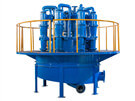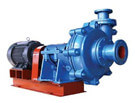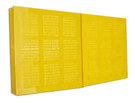Hot Product

- Hydrocyclone Group
Hydrocyclone group is widely used in coal preparation plant...

- Slurry Pump
Slurry pump is mainly used in mining, power plant, dredging, metallurgy...

- Polyurethane Dewatering Screen Panel
In addition to the performance of...
What Is Hydrocyclone Used For ?
Date: 2021-09-25 From: Longding Author: admin
Hydrocyclone is mainly used for separating materials according to the difference in mineral particle size and density. Hydrocyclones are often used for fine sand separation in sand washing plants, grading, sorting, concentration and desliming in beneficiation, tailings treatment, mud dewatering, sewage treatment, etc.
Hydrocyclone structure
The upper part of the hydrocyclone is a hollow cylinder, and the lower part is an inverted cone communicating with the cylinder. The upper end of the cylindrical cylinder is equipped with a feed pipe tangentially, and the top is equipped with an overflow pipe. There is a grit sink at the bottom of the conical cylinder. The parts are connected by flanges and screws. The mine-mouth, barrel, and grit mouth are usually lined with rubber or polyurethane to reduce wear and can be replaced after wear.
Hydrocyclone working principle
The material is fed into the inner wall of the cylinder at a high speed involute and tangential. The mixing body rotates to form a centrifugal force field, and particles of different sizes and densities will produce different trajectories. Under the action of centrifugal force, buoyancy, and gravity, coarse particles and high-density particles move to the periphery and are discharged from the grit through the cone. The mixture of fine particles and liquid moves to the center and is discharged from the overflow pipe, so as to realize the separation of coarse and fine particles of solid particles and fluids of different densities.
The velocity of each particle in the hydrocyclone can be decomposed into three directions, namely tangential, axial, and radial. Along the radial direction of the annular space on the periphery of the overflow pipe, the tangential velocity does not change much. In most of the cones, the tangential velocity increases as the radius decreases. When the tangential velocity reaches 0.5 to 0.7 times the radius of the overflow pipe, the tangential velocity decreases with the decrease of the radius. On the periphery of the overflow pipe, the radial velocity fluctuates up and down at zero speed. In the vertebral body, it increases as the radius decreases, but at the upper part of the cone near the wall, the radial velocity decreases as the radius decreases. On the periphery of the overflow tube, the axial velocity presents an asymmetrical parabola; in the cone part, it gradually decreases along the radial direction, and there is a zero-speed envelope surface.
Leave a Message
Here you can submit any questions and we will get back to you as soon as possible. We will not disclose the information you submit to anyone, please rest assured.



Inquiry